Maize TIMPs
Maize Zea mays is Kenya’s principal staple food crop. Mainly grown under rain-fed conditions and its production is limited by several factors, including frequent drought and poor distribution of rainfall that lead to total or partial crop failures, declining soil fertility, pests, diseases and noxious/parasitic weeds.
Enhanced adoption and use of technologies, innovations and management practices (TIMPs) would improve the production and utilization of maize and maize-based products.
Agro Ecological Requirements
Production of maize should be done on deep, fertile and free-draining soils.
Maize can be grown at altitudes ranging from 0 - 2200 meters above sea level. Various agro-ecological zones within this range of altitude require different varieties that are adapted to the various temperature and moisture regimes.
Maize crop is best suited to medium conditions of temperature, altitude, and rainfall.
Maize Varieties
The varieties to be grown should be suitable for the selected areas.
Farmers should seek advice from agricultural extension officers in their areas before purchasing the seeds since several varieties are available and newer ones are being developed and released. The following are key varieties and their characteristics.
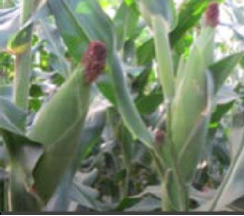
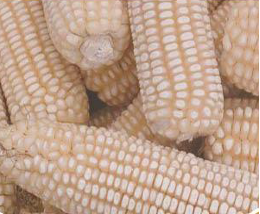
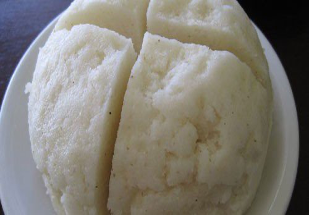
Coast Composite Maize (CCM)
\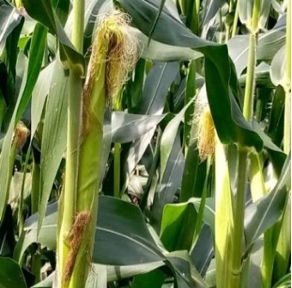
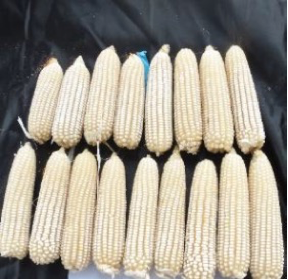
Description
- Open pollinated.
- Medium maturity (110-120 days).
- Yield potential: 16-21 bags per acre.
- Shiny flint kernels, a good husk cover.
- Heat tolerant.
- Resistant to common leaf rust.
- Suitable for cultivation under rain fed and irrigated conditions.
Region: Coastal Lowlands
WSQ104
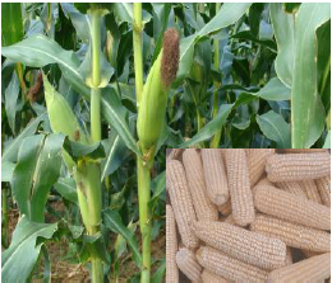
- Open pollinated quality protein maize variety.
- Extra early maturity (90 -105 days)
- Yield potential: 15 bags per acre
- Tolerant to drought.
- Kernels are white flint type.
Coastal Lowlands
KH 500

- A three-way cross hybrid.
- Medium maturity (90 – 120 days).
- Yield potential: 36 bags per acre.
- High protein (lysine and typtophan).
- Drought tolerant.
- Resistant to grey leaf spot, northern leaf blight and maize streak virus (MSV).
- Good husk cover and a white dent grain texture.
Coastal Lowlands
Pwani Hybrid 4 (PH4
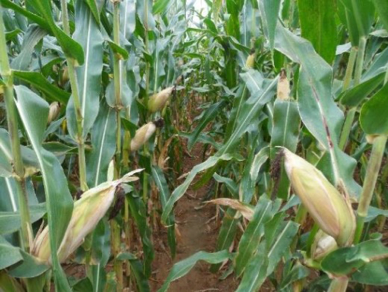
- Hybrid.
- Medium maturity (120-150 days).
- Average yield potential: 24 bags per acre.
- Tolerant to heat stress.
- Partial resistance to maize streak virus.
Coastal Lowlands
Shukran-16 (CKH08069)
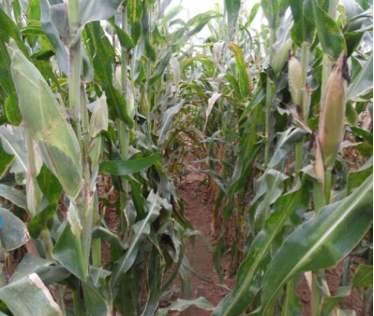
- Hybrid
- Medium maturity (90 – 120 days).
- Average yield potential: 18 bags per acre.
- Tolerant to drought.
- Resistant to most leaf and ear diseases.
- Excellent husk cover and tolerant to water lodging.
Coastal Lowlands
WE2111
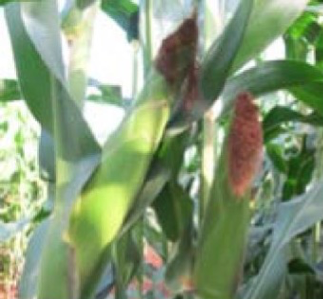
- A three-way hybrid.
- Matures in 4.5 to 5 months.
- Yield potential: 4.7 to 8.7 t/ha.
- Tolerant to drought.
- Resistant to major leaf diseases such as northern corn leaf blight, gray leaf spot, maize streak virus.
- White grains with dent-like texture
Coastal Lowlands
MTPEH0701
- A three-way cross hybrid.
- Medium maturity (120-150 days.)
- Yield potential: 26 bags per acre.
- Resistant to large grain borer and maize weevil.
Coastal Lowlands
MTPEH0702
- A three-way cross hybrid.
- Medium maturity (120-150 days).
- Yield potential: 26 bags per acre.
- Resistant to large grain borer and maize weevil.
Coastal Lowlands
MTPEH0703
- A three-way cross hybrid.
- Medium maturity (4-5 months).
- Yield potential: 26 bags per acre.
- Resistant to spotted stem borers.
Coastal Lowlands
MTPEH200804 (KH125 -02- MDR)
- A three-way cross hybrid.
- Medium maturity (120 days).
- Yield potential: 4.2 - 6.4 t/ha.
- Resistant to maize streak virus and gray leaf spot.
- Has a white cob.
Coastal Lowlands
MTPEH200805 (KH125-03-SG)
- Three-way cross hybrid.
- Stays green.
- Medium maturity (120 days).
- Yield potential: 5 - 6.4 t/ha.
- Tolerant to drought.
- Resistant to stem borers and gray leaf spot.
Coastal Lowlands
Katumani Composite B (KCB)
- An open pollinated variety.
- Early maturity (85-95 days).
- Yield potential: 16 – 21 bags per acre.
- Drought tolerant.
Medium altitude – Dry
KDH6 SBR
- A three-way cross hybrid.
- Medium maturity (90-120 days).
- Yield potential: 5 t/ha.
- Tolerant to drought and low nitrogen in the soil.
- Resistant maize stem borers.
Medium altitude – Dry
KH414-03 SBR
- A three - way cross hybrid.
- Medium maturity (90-120 days).
- Yield potential: 4 tons/ha.
- Tolerant to stem borers.
Medium altitude – Dry
KDH414-11 (Ukamez 6)
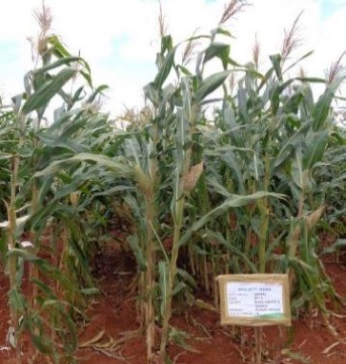
- A three-way cross hybrid.
- Early maturing (90 – 100 days).
- Yield potential: 4.6 - 7.5 t/ha.
- Drought tolerant.
- Resistant to major leaf diseases such as gray leaf spot, northern leaf blight and maize streak virus.
Medium altitude – Dry
KDH414-12 (Ukamez 7)
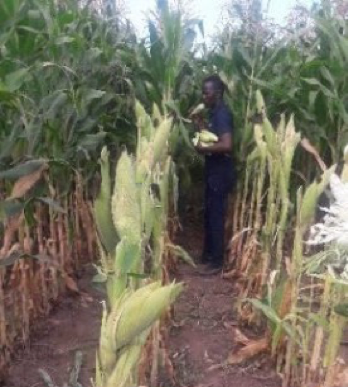
- A three-way cross hybrid.
- Stay green trait.
- Early maturing (90-100 days).
- Yield potential: 4.3 - 7.8 t/ha.
- Drought tolerant.
- Resistant to major leaf diseases such as gray leaf spot, northern leaf blight and maize streak virus.
Medium altitude – Dry
WE2109
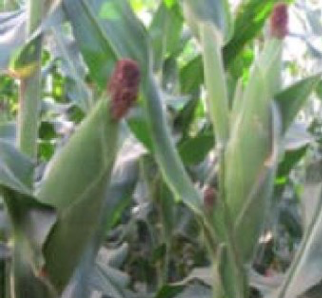
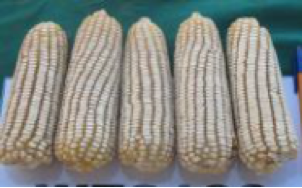
- A three-way cross hybrid.
- Medium maturing (4.5 – 5 months).
- Yield potential: 4.8 to 9.2 t/ha.
- Drought tolerant.
- Resistant to major leaf diseases such as northern leaf blight, gray leaf spot and maize streak virus.
- Good husk cover.
- Grains are white with dent-like texture.
Medium altitude – Dry
Food Safety Management System
- Designed to minimize the risk of food safety hazards.
- Identifying the hazards, establishing controls and monitoring these controls.
Good Agricultural Practices (GAP) for maize
Process of implementing a standardized production system globally designed to reassure consumers about how food is produced on the farm, pre-farm gate or on-farm standards.
Aflasafe KE01TM
-
Pre-harvest bio-control agent
-
Reduces aflatoxin contamination in maize by 80-99% at harvest and in storage.
-
Applied preharvest but has postharvest benefits
-
Dyed blue using food colour.
-
Broadcast by hand 2-3 weeks before flowering at the rate of 10 kg/ha (4 kg/acre)
Land preparation
- Should be done at least 2 weeks before the onset of rains to allow time for soil to break down, to expose soil pests to predators and adverse weather conditions, to allow decomposition of plant debris and to enhance air circulation so as to optimize maize plant growth.
- Can be done through deep ploughing or by practicing minimum and zero tillage by opening furrows for planting using rippers or holes.
- Ploughing once with a tractor followed by one harrowing are adequate. Alternatively, ploughing twice when using animal draught is recommended.
- Proper seedbed preparation is needed in controlling weeds, pests and diseases.
Maize variety (seed) selection
- Choosing the appropriate/recommended maize variety for a given agro ecological zone.
- Should match the climatic conditions, soil type, tolerance/resistance to pest and diseases prevalent in that region.
- Maturity period fits well in the growing season for the region.
Planting in rows and at recommended spacing
- Best maize plant population is attained by planting maize in rows at recommended spacing.
The recommended spacing and planting density for different areas is as shown in table below:
Region
Spacing
Density (plants per ha)
Highland areas
75x25cm 1 plant/hill (Maize alone)
53,333
75 x 50 cm 2 plants/hill (intercrop)
53,333
Medium altitude areas
75 x 30 cm 1 plant/hill (Maize alone)
44,444
75 x 60 cm 2 plants/hill (intercrop)
44,444
Dry lands and coastal areas
90 x 30 cm 1 plant/hill (Maize Alone)
37,850
90x 60 cm 2 plants/hill (intercrop)
Application of Fertilizers and Manures
- Soils in most maize growing areas have either been degraded or have low fertility leading to low crop yields.
- Fertilizers and manures should be used for more yields.
- There are fertilizers for use when planting (basic) and fertilizers for top dressing, especially for adequate supply of nitrogen and phosphorus:
- Basic fertilizer - The recommended basic fertilizers are NPK and DAP or organic fertilizers. The application of either depends on the acidic condition of the soil. In acidic soils NPK is recommended while in none acidic soils DAP can be applied. Apply during planting at the rate of 50kg/acre for DAP or 100kg/acre for NPK 23:23:0. Apply the fertilizer in the planting holes then mix with soil to protect the seed from scotching. Plant and cover the seed.
- Top-dressing - CAN fertilizer is used for top dressing when the crop is knee high. Weeding and thinning should be done before top dressing. Apply at the rate of 50Kg/acre. The fertilizer is applied around the crop avoiding direct contact to protect the crop from scotching.
WEED MANAGEMENT
Maize Integrated Weed Management
- Management of weeds using two or more appropriate approaches including preventive, planting in a weed free prepared land, use of mulch (biodegradable or synthetic), cultural, rotation, intercropping and chemical control depending on the weed types infesting the field, cultural includes transplanting rather than direct planting, proper fertilization, irrigation, use of cover crops and plastic mulch to reduce weed populations, physical control is the removal of weeds manually or by mechanical means.
Weed Control
- Weed control is important during the first 4-6 weeks after emergence of the maize crop.
- The most common practice in weed management is hand weeding and use of herbicides.
- Hand weeding should be done latest 3 weeks after emergence of the plants followed by a second weeding 3 weeks later.
- Herbicide application for weed control is mostly done before or immediately after planting for pre-emergence herbicides.
-
Herbicide (Chemical) Weed Control
-
- Involves the application of herbicide to weeds or soil to control the germination and growth of the weed species.
Solarization Bed for Weed Control
- use transparent polythene films and increase soil temperatures by 100C or more than atmospheric to kill weed seeds and seedlings.
Stale seed bed for Weed Control
- Seeds are allowed to germinate by rainfall or wetting and killing them (1-2 flushes of the weeds) before sowing the Clean certified maize variety seeds, they are killed using glyphosate, sulfosate and glufosinate.
Transplanting maize for weed control
- Prepare appropriate soil media. Mix with manure in the ratio 1:1. This is put in environmentally sound bags/Papers. Two clean certified maize seed variety of desired preference is sowed per polythene bag and kept in a slight shade and watered regularly for about 21-30 days before transplanting.
-
Mechanical weeding
Timely weeding is most effective at 2-3 weeks after sowing. Monitor weeds weekly and do a second weeding weed 2 to 3 weeks later.
-
-
Intercropping
- This is the growing of two or more crops in the same row or bed, or in rows or strips that are close enough).
- Intercropping maize with legumes (beans, cowpeas and green grams) ensures good use of the environmental resources, better land use efficiency, reduces weed problems through non-chemical methods and increased maize yields with limited resources.
Crop Rotation
- This is the practice of growing different crops every season on the same land to manage soil fertility, reduce soil erosion, improve soil health and increase nutrients availability to plants.
- Maize can be grown in rotation with a legume such as cowpeas.
Soil Fertility Management
- Integrated soil fertility management
- Use of fertilizers, locally available organic inputs and improved seed combined to adapt practices to local conditions.
Integrated Manure Management (IMM)
- the optimal, site-specific handling of livestock manure from collection, through treatment and storage up to application to crops.
Rapid Soil Testing Services
- Soils should be tested to be sure of the type of fertilizer to use. Soil testing services are offered at some KALRO Centres and other institutions.
Low-Cost Composting technology
Biological decomposition of organic waste such as food or plant material by bacteria, fungi, worms and other organisms.
Integrated soil fertility management
Soil and Water management
- Its farming in which the various practices follow key principles e.g., Minimal soil disturbance, Permanent ground cover and Crop rotation.
- Targets to conserve the soil, soil moisture, and soil-nutrients, and stabilize land production while reducing production costs.
Zai pits
- Zai Pits are small planting pits typically measuring 15-30 cm in width, 10-20 cm deep and spaced 60-80 cm. Zai Pits harvests and stores water for prolonged crop use.
- Farmers plant seeds into the pits after filling one to three handfuls of organic material such as manure, compost, or dry plant biomass.
- The technology is highly suitable for areas with unpredictable rains especially the drought-prone areas (Arid and Semi-Arid Lands).
Contour bunds
- Contour bunds are stone or earthen walls built across a slope to prevent runoff.
- Making furrows parallel to the contours ensures that rainfall and runoff are spread evenly over a field.
- The earthen bund is formed by excavating a channel and creating a small ridge on the downhill side.
- Contour bunds resemble narrow channel terraces commonly referred to as “fanyachini” terraces.
- The technology is highly suitable for areas with unpredictable rains especially the drought-prone areas (Arid and Semi-Arid Lands).
-
Bench Terraces
- They consist of a series of beds, which are more or less level running across a slope at vertical intervals, supported by steep banks or risers (walls or bunds).
- The flat beds created by bench terraces enable the cultivation of crops on medium to steep slopes.
- The technology is highly suitable for Semi-arid to humid regions of rainfall, 700 mm or more; medium to steep slopes (12- 47%) (Bench terraces are not recommended for slopes less than 12%); soil depth of greater than 50 cm; and areas with no gullies, nor stones.
Fanya Juu Teraces
- Constructed by excavating soil and throwing it up-slope to make an embankment.
- Embankments are stabilized with fodder grasses.
- Crops, such as bananas, paw paws, citrus and guava, are grown in the ditches.
- Highly suitable in low annual rainfall areas.
Grass strips
- Grass strips are dense strips of grass planted up to a meter wide, along a contour.
- With time, silt builds up above the strip and benches are formed.
- Spacing between grass strips depends on the slope of the land.
- It can be 20-30 m on gentle slopes and 10-15 m on steep land.
- Grass strips can be planted along ditches to stabilize them, or on the rises of bench terraces to prevent erosion.
- The grass needs to be trimmed regularly, to prevent shading and spreading to crop areas. Various grass species are used, e.g., Vetiver, Napier, Guinea and Guatemala depending on what is locally available.
- Vetiver grass is drought resistant and good for reducing erosion.
Stone Lines
- Stones placed along contour lines to slow down runoff.
- With time, the soil builds up on the upslope side of the stone line and a natural terrace is formed.
- Suitable in gentle to moderate slopes areas with low annual rainfall areas and stony areas
Tied Ridges
- Small earthen ridges, 30 cm high, with an upslope furrow which accommodates water between the ridges.
- Water flows down the small trenches/furrows running parallel and infiltrates into crop root zones. Water is applied to the top end of each furrow and flows down the crop field under the influence of gravity.
Retention Ditches
- Designed to catch and retain incoming runoff and hold it until it infiltrates into the ground.
- Can be an alternative to waterways in high rainfall areas, but they are most often used in semi-arid areas to harvest water.
- Suitable in semi-arid areas; permeable, deep and stable soils; and on flat or gentle sloping land.
Mulching
- Practice of covering the soil/ground with natural materials such as straw, grass, dead leaves and compost to make more favorable conditions for plant growth, development and efficient crop production.
- Retain moisture in the soil suppress weeds keep the soil cool and help improve soil fertility (as the mulches decompose).
Intercropping
- Growing of two or more crops in close proximity (in the same row or bed, or in rows or strips that are close enough) for biological interaction.
- Growing of two or more cash crops together.
- Offers the potential to increase yields, enhance soil fertility and minimize the effects of climate change.
Irrigation and Drainage Management
Furrow Irrigation Systems
- Supplements water in crop production systems.
- Trenches or “furrows” are dug between crop rows in a field. Farmers then flow water down the furrows (often using only the force of gravity), and the water seeps vertically and horizontally to refill the soil reservoir.
- It’s easy to design and operate.
AGROFORESTRY SYSTEMS
Agroforestry for soil fertility
- Leguminous trees planted in natural fallows Hedgerow intercropping /alley cropping.
- Leguminous tree species planted in hedges Green manure; biomass from growing leguminous plants that are cut at a certain height and ploughed back to the soil as source of manure Mixed cropping; system of sowing two or three crops (that includes a legume) together on the same land, where one is the main crop and others are considered subsidiaries.
Integrated Management of Pests and Diseases
Pest/Disease
Fall armyworm
Management Measures
- Planting time management - plant early to avoid the build-up of pest population, avoid late or off-season planting, ensure that the young crop is not planted next to an older crop
- Cultural methods –Walk around the farm and check for pests using pheromone traps, removal and destruction of infested plant materials, ploughing deep to expose the pupae to predators and solar heat, remove weed as they serve as areas that keep the pest season after season.
- Physical control - pick larvae and crush them; put a half handful of sand or sawdust or soil in the parts of the plant, apply a pinch of 50gm ground hot pepper.
- Use neem-based products.
- Use appropriate synthetic pesticides.
Note: The Pest Control Products Board (PCPB) provides lists of pesticides that are registered for control of specific pests (www.pcpb.go.ke). Use products according to the manufacturer’s instructions.
Bollworm (Heliothis armigera)
Management Measures
- Cultural methods – Always walk around the farm and check, plant clean seed free of caterpillars, remove and destroy or dig out crops that were left in the farm, practice crop rotation, weed farm since some weeds in the maize family could serve as pest hosts.
- Planting time management - ensure that a young crop is not planted next to an older crop.
- Mechanical control - pick eggs and caterpillars and crush them.
- Use neem-based products.
- Use appropriate synthetic pesticides.
- Avoid using broad-spectrum insecticides early in the season when the boll worm is present in low numbers may preserve natural enemies that can help keep bollworm populations under control later in the season.
Note:The Pest Control Products Board (PCPB) provides lists of pesticides that are registered for control of specific pests (www.pcpb.go.ke). Use products according to the manufacturer’s instructions.
Stem Borer using Neem
Management Measures
- Use of neem-based products e.g. Nimbecidine, Neemroc 0.03% and Achook 0.15%.
- Push-pull technology - maize is intercropped with desmodium, a forage legume, and Napier grass is planted as a border crop. Desmodium repels stem borer moths while Napier grass attracts them. Desmodium can be replaced with Clitolaria while Bracharia grass can replace napier grass in drought prone areas.
- Use appropriate synthetic pesticides.
Note: The Pest Control Products Board (PCPB) provides lists of pesticides that are registered for control of specific pests (www.pcpb.go.ke). Use products according to the manufacturer’s instructions.
Stem Borer using Push- Pull
Aphids (Rhopalosiphum maydis)
Management Measures
- Carry out regular checks and use yellow traps to look for population onset.
- Remove plants left in the farm after harvesting.
- Maintain a weed free farm.
- Conserve natural enemies such as ladybird beetles, syrphids and parasitic wasps exert good control by using compatible pesticide products.
- Use bio pesticides and neem-based products.
- Use appropriate synthetic pesticides.
Note: The Pest Control Products Board (PCPB) provides lists of pesticides that are registered for control of specific pests (www.pcpb.go.ke). Use products according to the manufacturer’s instructions.
African armyworm
Management Measures
- Cultural methods – Walk around the farm and check for pest using pheromone traps, removal and destruction of infested plant materials, ploughing deep to expose the pupae to predators and solar heat, remove weeds as they keep the pest season after season.
- Physical control - pick larvae and crush them; put a half handful of sand or sawdust or soil in the parts of the plant, apply a pinch of 50gm ground hot pepper.
- Use bio pesticides and neem-based products.
- Use appropriate synthetic pesticides.
Note: The Pest Control Products Board (PCPB) provides lists of pesticides that are registered for control of specific pests (www.pcpb.go.ke). Use products according to the manufacturer’s instructions.
Cut worms (Agrotis spp)
- Management Measures
- Dig deep to remove all weeds and expose caterpillars to natural enemies and sunlight at least 2 weeks before planting.
- Ensure proper weeding to remove alternative hosts.
- Do solarization to destroy soil borne pests.
- Use bio pesticides and neem-based products.
- Use appropriate synthetic pesticides.
Note: The Pest Control Products Board (PCPB) provides lists of pesticides that are registered for control of specific pests (www.pcpb.go.ke). Use products according to the manufacturer’s instructions.
Yellow aphid traps
Management Measures
- Cultivation of land in dry spell reduces the colonies of ants which always protect aphids from potential predators thus enabling them to increase in population, is recommended.
- The use of heavy doses of highly soluble nitrogen fertilizers makes leaves tender and highly succulent and this attracts aphids.
- It is advisable to practice split application of nitrogen during seedling and flowering stage.
- Frequency to determine the presence of the different types of pests and their respective populations in a maize field in order to make a decision on the control measures to be undertaken.
Thrips (Frankliniella spp.)
Management Measures
- Walk around the maize farm twice weekly, looking under the leaves and bud areas for thrip.
- Remove and destroy or dig out crops left in the farm.
- Practice crop rotation.
- Ensure that a young crop is not planted next to an older crop.
- Weed farm since some weeds in the maize family could keep pest.
- Use bio pesticides and neem-based products.
- Use appropriate synthetic pesticides.
Note: The Pest Control Products Board (PCPB) provides lists of pesticides that are registered for control of specific pests (www.pcpb.go.ke). Use products according to the manufacturer’s instructions.
Maize lethal necrosis disease
Management Measures
- Use approved seeds applied with insecticides or approved seed of resistant varieties.
- Check for insect (aphids, thrips, beetles) that transmit the virus in order to take action.
- Check for symptoms of the disease and take the action.
- Keep farms free from weeds that could keep diseases.
- Avoid continuous planting to prevent overlap of two maize crops.
- Rotate maize with potatoes, cabbages, beans and other crops for at least 2 seasons.
- Intercrop with chives, garlic, radish, or parsley to repel virus vector (aphids).
- Avoid moving plants from infected to non-infected regions.
- Uproot and destroy diseased plants by burning or burying.
- Use of bio-pesticides and soft/safe synthetic pesticides to control vectors.
Note: The Pest Control Products Board (PCPB) provides lists of pesticides that are registered for control of specific pests (www.pcpb.go.ke). Use products according to the manufacturer’s instructions.
Maize Common Rust (Puccinia sorghi)
Management Measures
- Use approved seeds.
- Plant early at the onset of rains and at proper spacing.
- Do timely weeding to eliminate weeds that keep diseases.
- Rogue out infected plants.
- Do crop rotation with non-host crops.
- Plant tolerant varieties.
- Apply appropriate fungicides.
Note: The Pest Control Products Board (PCPB) provides lists of pesticides that are registered for control of specific pests (www.pcpb.go.ke). Use products according to the manufacturer’s instructions.
Maize Common Smut (Ustilago maydis)
Management Measures
- Remove infected plants as early as possible and burn infected maize heads.
- Avoid feeding livestock with infected maize residues.
- Plant approved disease-free maize seeds; seeds known to carry high levels of loose smut fungus should not be sown.
- Plant at the onset of rains.
- Practice crop rotation for at least 4 seasons with beans, tomato, maize, cassava and sweet potatoes.
- Plant tolerant varieties like WH699.
- Apply systemic seed treatment fungicides (e.g. seed dress with products containing carboxin and thiram.
Downy mildew (Perenosclerospora sp)
Management Measures
- Plant at recommended spacing to reduce overcrowding which helps disease spread.
- Carry out rotation of maize with non-brassica crops for 2-3 seasons.
- Ensure farm cleanliness.
Note: The Pest Control Products Board (PCPB) provides lists of pesticides that are registered for control of specific pests (www.pcpb.go.ke). Use products according to the manufacturer’s instructions.
Grey leaf spot (Cercospora spp.)
Management Measures
- Ensure farm cleanliness.
- Keep farm free of weeds to avoid weeds that keeps diseases
- Avoid overhead irrigation to minimize spread through splash.
- Use approved fungicides.
- Use varieties with tolerance/resistance to leaf spot diseases.
Note: The Pest Control Products Board (PCPB) provides lists of pesticides that are registered for control of specific pests (www.pcpb.go.ke). Use products according to the manufacturer’s instructions.
Maize Streak Virus disease
Management Measures
- Use approved seed.
- Plant tolerant varieties e.g. Pan 5195, PH 4, FS 650, Duma 43and PAN 67.
- Check and control insect vectors (leaf hoppers) that transmit the virus.
- Remove and destroy severely affected plants.
- Use bio-pesticides and soft/safe synthetic chemicals to control the vector.
Note: The Pest Control Products Board (PCPB) provides lists of pesticides that are registered for control of specific pests (www.pcpb.go.ke). Use products according to the manufacturer’s instructions
Aspergillus ear rot
Management Measures
- Use approved non-infected seeds.
- Plant early at the start of rains to escape drought which favours development of fungus.
- Apply nitrogen fertilizer (Basal: 20-40 kg/ha) and top dress (20 kg/ha Urea) to overcome stress due to fertility.
- Harvest the grain early when dry to avoid spread of fungus to uninfected cobs.
- Destroy crop residues by burning.
- Rotate maize with soya beans, cowpea and beans.
Fusarium Ear Rot
Management Measures
- Use approved non-infected seeds.
- Plant early at the start of rains to escape drought which favours development of fungus.
- Apply nitrogen fertilizer (Basal: 20-40 kg/ha) and top dress (20 kg/ha Urea) to overcome stress due to fertility
- Harvest grain early when dry to avoid spread of fungus to uninfected cobs.
- Rotate maize with soya beans, cowpea and beans.
- Plant tolerant varieties.
- Control stalk borers as they carry the fungus using bio pesticides or soft/safe synthetic pesticides.
Maturity Assessment and Harvesting
- Green maize is ready for harvest when the silk is dry (and has turned black in colour).
- Dry maize should be harvested at maturity to avoid losses caused by delayed harvesting, left overs during stooking, poor supervision during de-husking and spillage during transportation to stores.
- Dry maize is considered to be mature when most leaves have dried up, cob husks are dry, grains are hard (not milky) and kernels have a black layer between the seed point and point of attachment to the cob.
Stooking of Maize During Harvesting
- This is a management practice where maize stalks are cut using sickle and machete (panga) and stooked on farm or carried to the storage area during dry weather conditions to prevent rotting.
- Stooking allows maize to dry on farm and cobs are picked easily from one spot.
Maize crib for drying maize cobs
- This is a well-ventilated store for temporary holding maize cobs till they are dry enough for threshing.
- Cribs are long and narrow, with wooden slats or chicken wire sides that allow free ventilation, and a roof that protects against rain.
- To protect from rodents, the legs of the crib should be 1m above the ground level, beyond the maximum distance that rodents can jump.
- The legs are supplied with rodent guards that will keep rodents out.
- The cribs are built across the prevailing wind direction to promote drying. The maximum width of a crib - 0.6m in humid areas, 1.0m in drier zones and 1.5 m in very dry places.
Post-Harvest Handling
Tarpaulins for drying maize cobs
- This is a large plastic sheet or canvas that can be laid out in the sun for drying maize on cobs before shelling.
- To make the process of drying quicker, cobs should be placed in single layer and turned at intervals of every hour. If they are placed on a deep layer on the tarpaulin, then drying will be slower.
- Protect grain from rain and night dew by covering with a tarpaulin in case of any rainfall.
Shelling of maize using hand shellers and motor-driven shellers
- Shelling is the process of separating maize grain from cobs.
- A hand Sheller can shell 7-12 kg of maize per hour.
- Motorized grain shellers can shell 50-130 kg of maize per hour and are good for large scale production.
Drying grain after shelling
- The moisture content of maize grain should be reduced to the recommended safe moisture content for storage (13%).
- Ways available for drying shelled maize grain include the following:
-
Sun drying on tarpaulins
- Heavy-duty polythene sheets or sheets made from cut-open nylon sacks can be used.
- Turning over the grain several times a day makes it dry quickly.
-
Solar wrap drying –
- Solar radiation on plastic heats the air trapped between the plastic and the shelled maize that has been placed on the trays.
- The solar panel powers fans which circulate hot air inside the tarpaulin and hence improves drying efficiency.
-
Greenhouse solar dryer
- The grain to be dried is placed on benches in a tunnel greenhouse.
- Ventilators are placed on the roof to exhaust hot air
-
Electric dryers
- An electric or diesel powered grain dryer which can dry 80 bags of maize (from 22% moisture to 13% moisture).
- It can be rented.
-
DeHytray
- A simple solar tray measuring about 0.4m width, 0.85m long and 0.13m high.
- The tray is black to absorb and radiate solar energy, and has temperature and relative humidity control vent.
-
Grain moisture meter
- An electronic meter for quick and accurate measuring of grain moisture content.
-
Hygrometer for maize moisture determination
- A small portable digital hygrometer for checking the relative humidity of maize.
- The device and grain is put in an airtight container, and the reading taken after 10-15 minutes to give Relative Humidity of dry grain.
- If Relative Humidity is less than 65%, the grain is dry and can be stored; otherwise continue further drying of the grain
-
Moisture content determination by biting the grain or pinching with fingers:
- Sufficiently dry grain will be hard and does not break easily into many parts when bitten or pinched with fingers.
-
Moisture content determination using salt method:
- A mixture of dry salt and grain is put in a glass bottle, shaken and allowed to stand for 15 minutes. If after 15 minutes the salt sticks to the side of the bottle, then the moisture content of the grain is above 15% and the grain is not safe for storage.
- If the salt does not stick to the bottle, then the moisture content is below 15% and the grain is safe for storage.
-
Winnowing:
- Winnowing is done to improve grain quality by removing chaff, dust, foreign matter such as stones, broken grains, shrivelled, and any remaining plant parts grains.
- Winnowing is done manually using a winnowing tray (‘uteo’) or using motorised threshing and winnowing machines.
Storage
Hermetic Storage Bags - Purdue Improve Crop Storage (PICS), Agro-Z, GrainPro:
- This are airtight bags that prevent air and water from getting into the cereals stored in them.
- The bags eliminate maize pests (such as weevils and larger grain borer) by depleting oxygen.
- The bags consist of one or two-layer envelope made of 80μm thick high density polyethylene (HDPE) liners inserted in an outer woven polypropylene sack.
- The HDPE liners have low permeability to air, and are thus able to secure a modified low oxygen and high carbon dioxide atmosphere generated by respiration of the grain, insects and other life-forms enclosed when the bag once sealed.
Metal silo
- A cylindrical structure, constructed from galvanized iron sheet (gauge No. 26 or 0.5 mm thickness) and hermetically sealed (air-tight and moisture-proof).
- Metal silos effectively protect stored grains from rodents, birds and moisture that results in growth of moulds in the grains.
- The capacity of the silos ranges from 1, 8, 12 and 1,000 bags.
-
Maize store
- A storage structure for storage of the bagged grains and ensures that the bags are not attacked by rodents.
- Bags should be placed on pallets (wooden structures) not directly on the floor. These can stay for at least 8 months while still in good condition.
- The storage structure also maintains the quality of the grain.
- The store can adopt acoustic technology to monitor and control insect infestation of the store.
Corn starch
- Obtained from the endosperm of the kernel.
- Corn starch is a common food ingredient, often used to thicken sauces or soups, and to make corn syrup.
Tortillas
- A thin, flat pancake made from maize flour, eaten hot or cold, typically with a savoury filling.
- The dough and flour used to make tortilla is made through a process called nixtamalization (explained below).
Ogi
- A fermented cereal pudding, typically made from maize.
- It is commonly served for breakfast and dinner, but often has a thinner gravy-like consistency
Popcorn
- A maize variety with hard kernels that swell up and burst open when heated. It is commonly served as a snack.
Corn oil
- Oil obtained from the germ of maize, used in cooking and salad dressings.
-
-
Maize beer
- An alcoholic drink made from yeast-fermented malt flavoured with hops. It is commonly served as drink.
Maize candy
A molded candies resembling corn kernels in shape and having usually yellow bases, orange middle sections, and white tips. Usually consumed as snack.
Corn sauce or fermented corn sauce
- Produced by fermentation using corn starch as the primary substrate. It is commonly served as a snack.
Corn syrup
- A fermented cereal pudding, typically made from maize. It is commonly served for breakfast and dinner, but often has a thinner gravy-like consistency.
Maize crackies
- A deep fried snack mainly made from maize flour
Maize sausage
- A snack made from minced meat and maize flour.
- Milk or water and baking powder is added to the mixture to make a dough.
- The dough is moulded into oval shapes of 2 cm diameter then deep fried in hot oil until brown.
Maize kebab
- Is an oval shaped snack made using dough from a mixture of minced meat and maize flour which is dipped in beaten eggs before deep fried to have the desired colour.
Maize mandazi
- A snack made from maize flour and wheat mixed in the ratio of 2:1 respectively.
- Milk is added to the mixture to make a dough which is rolled into 1 cm thickness and cut into desired shapes. These are then deep fried in hot oil until golden brown.
Maize cake
- A snack made from maize flour and wheat mixed in the ratio of 2:1 respectively.
- Sugar, margarine and baking powder are added to the mixture and mixed with water or milk to make a smooth free flowing paste.
- The paste is poured onto a well-greased baking pan and baked in a hot oven (190 °C) for 1 hour and 20 minutes or until golden brown.
Maize cookies
- Small, flat sweet snacks made from maize flour and wheat mixed in the ratio of 1:1 respectively.
- Beated eggs and fat are added to the mixture and mixed in to a fine dough which is cut and moulded into round small sized balls.
- The balls are placed on a well-greased baking tray and pressed down with a fork.
- These are then baked in a hot oven (190°C) until golden brown.
Nixtamalization
- This is the cooking of maize in Lime.
- Dry maize is boiled for 25-30 minutes in water where food grade lime has been added.
- Alternatively, dried empty beans pods ash or maize cob ash can be used.
- The maize is then washed and either wet milled to form a dough or Masa or it can be sundried and ground to make flour.
- Both the dough and flour can be used to make a wide variety of value-added products including kebab, mandazi, cake, crackies, cookies, tortillas, maize sausages.
Note: The maize flour used in making maize cookies, sausages, mandazi, kebab cakes and other products is made through a process called nixtamalization.
Power tiller
- Low powered, two-wheeled, 8-16hp agricultural implement (a walking tractor)
- Can be attached to a rotary tiller, disk harrow, mouldboard plough, trailer, water pump or chisel plough at alternate times for easing farm operations.
- Can plough one hectare 2 hours.
- Fuel consumption is about 15 litres per ha
Wheeled tractor
- Small sized, 4 wheeled, 30-55hp tractor
- Can be attached to a rotary tiller, disk harrow, mouldboard plough, trailer, water pump or chisel at alternate times for easing farm operations.
- Can complete 4 hectares in 8 hours and double that figure when two operators are used.
- Fuel consumption is about 15 litres per ha.
Mouldboard plough
- Used as a tillage implement when attached to power tiller or tractor.
- Does the following:
a) Cutting the furrow slice
b) Lifting the furrow slice
c) Inverting the furrow slice
d) Pulverizing the furrow slice
Disc harrow
- An implement consisting of a heavy frame set with teeth or tines.
- Dragged over ploughed land to break up clods, remove weeds, and cover seed.
- Used primarily for breaking up and smoothing the soil in preparation of a seedbed for small sized grain planting.
Planter
- Used for sowing single seed or double seeds.
- Can finish furrowing, fertilizing, covering earth and pressing at in one operation.
Motorized sprayer
- Used in spraying insecticides, herbicides, fertilizers, water on agricultural crops on the farm.
- Uses gasoline mixed with engine oil to function.
Power weeder
- Self-propelled with a fully functional gear box having one forward and reverse gear transmission with clutch.
- Used for removing the weeds, stirring and pulverizing the soil and for loosening the soil after the crop has begun to grow.
Maize harvesting machine
- Can work single row corn.
- Can work with tiller and walking tractor.
Maize Sheller
- Simultaneously threshes, polishes and winnows maize.
- Can also thresh and winnow a variety of leguminous crops like pigeon peas, Lablab, sesame, green grams and soya.
Basic costs/Estimated Returns
- The average total production cost for maize is KES 25,849 and 27,038 per acre with land preparation contributing the highest cost at KES 3,625 and KES 4,767 in small- and large-scale systems, respectively.
- The average price per 90-kg bag is from KES 2,200 to KES 3,000.
Marketing
Collective Marketing
- Individual farmer marketing increases inaccessibility to markets due to low volumes and low prices.
- Marketing as a group is a collective marketing approach. It involves formation of a group of farmers with an objective of reducing market inaccessibility.
- Due to small-scale farming of maize, marketing as a group would enable farmers to gain more profit. The advantages of collective marketing are bigger volumes, uniform quality, reliable sellers, reliable buyers, continuous supply, higher price and organization.
Business Planning
- With a business plan in hand, maize farmers will be able to take that first step toward the creation of a successful and sustainable farming. Below are the steps for creating a business plan.
Mission Statement
- Your farm business mission statement is your main purpose for your business. Why does your farm exist? What purpose does your farm serve? Where is your farm headed?
- Your mission statement should be based on your values and your core identity as a small farm.
Goals
- These should be specific, measurable, things that you might achieve with your little farm.
- Short term goals are considered to take shorter than one year while long-term goals take more than a year to accomplish. Smart Goals are:
- Specific
- Measurable
- Attainable
- Rewarding, and have a timeline
Background Information
In this area of your business plan, take account of what you have right now. These might include;
- The area of land that you are farming.
- When you began farming.
- How you are operating currently.
- What general practices do you use for such things as conservation, tillage, environmental impact, and marketing?
Farm Strategy
- Formulate your farm strategy from now into the next five years or so.
- You will need to gather information and research markets.
- Make sure that your farm plan fits into the general market in terms of supply and demand.
- Investigate and understand industry trends, identify competitors, and define markets.
Marketing Plan and Strategy
- You need to develop and outline a marketing strategy for your products
- This can build on the research you did in the previous step.
- For each product, include price, placement, and promotion ideas.
- Consider how you will convey real and perceived value to your customers.
Management Summary
- This part of your business plan details your farm business’ structure.
- Everyone who is involved in the management of the business should be listed here.
- External resources are listed here as well.
Financial Analysis
- You will need to detail the financial aspect of your farming operation.
- List your current finances in detail, including all income and operating expenses.
- Referring to your new strategy, you will forecast what is needed for future growth and to meet the goals you have listed in terms of capital.
- Include what your future operating expenses will be.
-
Internet, online and mobile marketing
- Internet marketing reduces costs. Examples of internet markets are:
- National Farmers Information Service(NAFIS) can be found using phone by typing http://www.nafis.go.ke on google.
- Kenya Market Information System(KAMIS)can be found using the phone by typing http://www.amis.co.ke .https://infonet-biovision.org/PlantHealth/Crops/Maize
Contacts
Kenya Agricultural and Livestock Research Organization
P.O. Box 57811-00200, Nairobi, Kenya
Call: 0111010100.